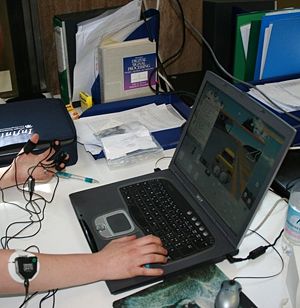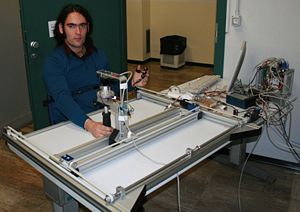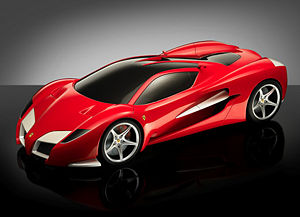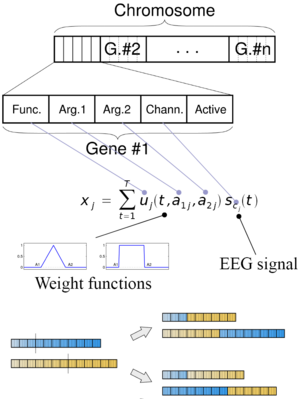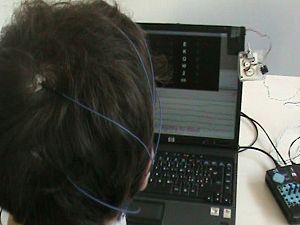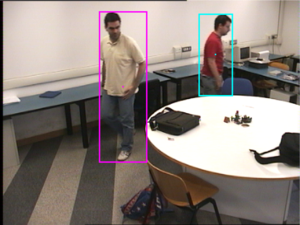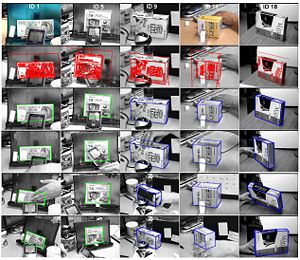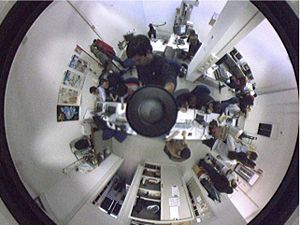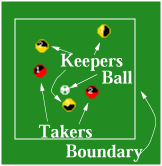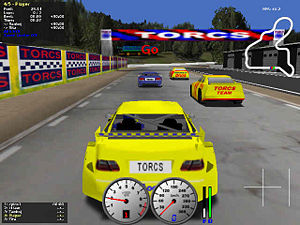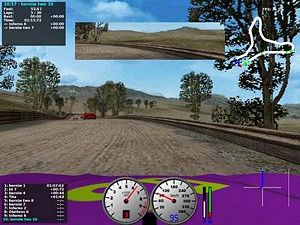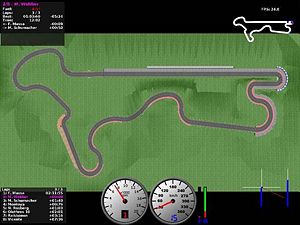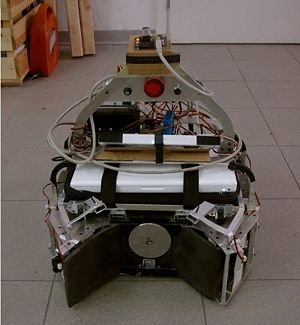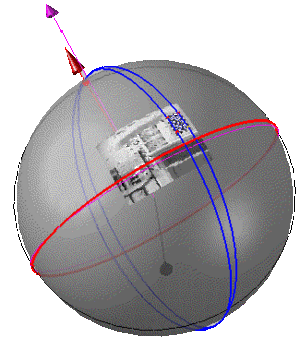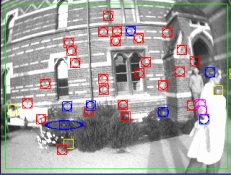Difference between revisions of "Master Level Course Projects"
(→Computer Vision and Image Analysis) |
(→Computer Vision and Image Analysis) |
||
| Line 338: | Line 338: | ||
|start= Anytime | |start= Anytime | ||
|number=1-3 | |number=1-3 | ||
| − | |cfu= | + | |cfu=2.5-15 |
|image=CIR.gif | |image=CIR.gif | ||
}} | }} | ||
Revision as of 11:33, 17 October 2008
Here you can find a list of project proposals for the courses of "Laboratorio di Intelligenza Artificiale e Robotica" (5 CFU for each student) and "Soft Computing" (1 CFU for each student)
Contents
Affective Computing
| Title: | Affective VideoGames | |
|---|---|---|
| Description: | The goal of this activity is to develop an interactive video game (Car game, Shoot them up, Strategic game ..) able to adapt its behaviour in order to maximize your enjoyment. The game will measure your excitement by analizing your biological signals, which mirror your emotional state. The system will be able to adjust some parameters (i.e difficulty of car game circuits, opponets strength ...) in order to keep you egnagemet constant: "In your flow zone!".
Project phases:
These projects allow to experiment with biological-data acquisition tools and videogames design. Each project consists on the realization of one or more phases depending on the difficulty/cfu to be achieved and to the competences of the candidate(s) | |
| Tutor: | Cristiano Alessandro (alessandro-AT-elet-DOT-polimi-DOT-it), Simone Tognetti (togetti-AT-elet-DOT-polimi-DOT-it) | |
| Start: | Anytime | |
| Number of students: | 1 to 3 | |
| CFU: | 2.5 to 20 |
| Title: | Affective recognition in multimedia contexts | |
|---|---|---|
| Description: | The goal of this activity is to develop an interactive multimedia application (advertisement, e-learning, reccomenadation system) able to capture your emotional state (interests, excitement, anger, joy) while whatching to images, sounds etc. The application will measure your excitement by analizing your biological signals, which mirror your emotional state. The system could be used to give feedback on the quality of multimedia content (i.e goodness of the advertisement, enjoyment of the movie ...)
Project phases:
These projects allow to experiment with biological-data acquisition tools and multimedia application design. The project consists on the realization of one or more phases depending on the difficulty/cfu to be achieved and to the competences of the candidate(s) | |
| Tutor: | Cristiano Alessandro (alessandro-AT-elet-DOT-polimi-DOT-it), Simone Tognetti (togetti-AT-elet-DOT-polimi-DOT-it) | |
| Start: | Anytime | |
| Number of students: | 1 to 3 | |
| CFU: | 2.5 to 20 |
| Title: | Affective robotics | |
|---|---|---|
| Description: | The goal of this activity is to develop an rehabilitation robotic game able to capture your emotional state (interests, excitement, anger, joy, stress) while intereacting with the robot. The application will measure your excitement by analizing your biological signals, which mirror your emotional state. The system could be used to adapt the therapy (executed by the game) according to the patien's needs. We believe the quality of the theraphy is related to the subject's emotional state. The long term goal is to keep the user into a specific emotional state in order to maximize the theraphy efficacy.
Project phases:
These projects allow to experiment with biological-data acquisition tools, robots and videogame design. The project consists on the realization of one or more phases depending on the difficulty/cfu to be achieved and to the competences of the candidate(s) | |
| Tutor: | Cristiano Alessandro (alessandro-AT-elet-DOT-polimi-DOT-it), Simone Tognetti (togetti-AT-elet-DOT-polimi-DOT-it) | |
| Start: | Anytime | |
| Number of students: | 1 to 3 | |
| CFU: | 2.5 to 20 |
| Title: | Driving companions | |
|---|---|---|
| Description: | The goal of this activity is to develop an application that is able to capture your emotional state (stress, attention level .. ) while driving standard cars. The application will measure the driver's stress level by analizing his biological signals, which mirror the phisiological state, and could be used to give feedbacks to the driver in dangerous situations.
Project phases:
These projects allow to experiment with biological-data acquisition tools, robots and videogame design. The project consists on the realization of one or more phases depending on the difficulty/cfu to be achieved and to the competences of the candidate(s) | |
| Tutor: | Cristiano Alessandro (alessandro-AT-elet-DOT-polimi-DOT-it), Simone Tognetti (togetti-AT-elet-DOT-polimi-DOT-it) | |
| Start: | Anytime | |
| Number of students: | 1 to 3 | |
| CFU: | 2.5 to 20 |
| Title: | Emotion from interaction | |
|---|---|---|
| Description: | The goal of this activity is to detect emotional states, such as stress or boreness from the interaction with the computer via mouse and keyboard (Emotion from Interaction). A library getting data from these devices has been already developed. Data have to be acquired in different situations and analyzed by neural networks or other classification tools already implemented. | |
| Tutor: | Andrea Bonarini (bonarini-AT-elet-DOT-polimi-DOT-it) | |
| Start: | Anytime | |
| Number of students: | 1 to 2 | |
| CFU: | 5 to 12.5 |
BioSignal Analysis
| Title: | Human-computer interaction via voice recognition system | |
|---|---|---|
| Description: | We want develop a system to allow a voice interaction between the user and the wheelchair.
This project consists in develop one of the solutions proposed in literature and extended the LURCH software to include this kind of interface.
References:
| |
| Tutor: | Matteo Matteucci (email), Davide Migliore (email) | |
| Start: | Anytime | |
| Number of students: | 1-2 | |
| CFU: | 2.5-10 |
Brain-Computer Interface
| Title: | Development of an existing genetic algorithm for ERP-based BCIs | |
|---|---|---|
| Description: | Different event-related potentials (ERPs) are used in BCIs, e.g., P300 and error potentials.
A genetic algorithm (GA) for ERP feature extraction has been developed at the Airlab. The GA has been proved to work, but there different ways that can explored to further develop this algorithm and expand its application field.
| |
| Tutor: | Matteo Matteucci (email), Bernardo Dal Seno (email) | |
| Start: | Anytime | |
| Number of students: | 1 | |
| CFU: | 5-20 |
| Title: | Driving an autonomous wheelchair with a P300-based BCI | |
|---|---|---|
| Description: | This project pulls together different Airlab projects with the aim to drive an autonomous wheelchair (LURCH) with a BCI, through the development of key software modules. Depending on the effort the student is willing to put into it, the project can grow to a full experimental thesis.
| |
| Tutor: | Matteo Matteucci, Bernardo Dal Seno | |
| Start: | November 2008 | |
| Number of students: | 1 | |
| CFU: | 5-20 |
| Title: | Online automatic tuning of the number of repetitions in a P300-based BCI | |
|---|---|---|
| Description: | In a P300-based BCI, (visual) stimuli are presented to the user, and the intention of the user is recognized when a P300 potential is recognized in response of the desired stimulus. In order to improve accuracy, many stimulation rounds are usually performed before making a decision. The exact number of repetitions depends on the user and the goodness of the classifier, but it is usually fixed a-priori. The aim of this project is to adapt the number of repetitions to changing conditions, so as to achieve the maximum accuracy with the minimum time.
Depending on the effort the student is willing to put into it, the project can grow to a full experimental thesis.
| |
| Tutor: | Matteo Matteucci, Bernardo Dal Seno | |
| Start: | Anytime | |
| Number of students: | 1 | |
| CFU: | 5-20 |
| Title: | Reproduction of an algorithm for the recognition of error potentials | |
|---|---|---|
| Description: | Error potentials (ErrPs) are event-related potentials present in the EEG (electroencephalogram) when a subject makes a mistake or when the machine a subject is interacting with works in an expected way. They could be used in the BCI field to improve the performance of a BCI by automatically detecting classification errors.
The project aims at reproducing algorithms for ErrP detection from the literature.
| |
| Tutor: | Matteo Matteucci, Bernardo Dal Seno | |
| Start: | Anytime | |
| Number of students: | 1 | |
| CFU: | 5-15 |
Computer Vision and Image Analysis
| Title: | Environment Monitoring | |
|---|---|---|
| Description: | The goal of this project is to develop a video surveillance system to track in 3D vehicles or people.
The idea is to use one or more calibrated camera to estimate the position and the trajectories of the moving objects in the scene. The skills required for this project are:
The project can be turned into a thesis extending the algorithm for a generic outdoor environment. | |
| Tutor: | Matteo Matteucci (email), Davide Migliore (email) | |
| Start: | Anytime | |
| Number of students: | 2-3 | |
| CFU: | 10-15 |
| Title: | Visual Merchandising | |
|---|---|---|
| Description: | The goal of this project is to develop algorithms to count the number of products on the shelves of a market.
The idea is to use a calibrated camera to recognize the shelves, estimate the scale and improve the image quality. The skills required for this project are:
| |
| Tutor: | Matteo Matteucci (email), Davide Migliore (email) | |
| Start: | As soon as possible | |
| Number of students: | 2-3 | |
| CFU: | 2.5-15 |
| Title: | Analysis of patch recognition algorithms | |
|---|---|---|
| Description: | Extract distinctive features from images is very important in computer vision application.
It can be used in algorithms for tasks like matching different views of an object or scene (e.g. for stereo vision) and object recognition. The aim of this work is to integrate in an existent framework the existing solution proposed in literature. Skills
References: | |
| Tutor: | Matteo Matteucci (email), Davide Migliore (email) | |
| Start: | Anytime | |
| Number of students: | 2-3 | |
| CFU: | 2.5-15 |
| Title: | Catadioptric MonoSLAM | |
|---|---|---|
| Description: | The goal of this work is to investigate a SLAM solutions based on catadioptric camera, integrating the solution presented in literature into an existing frameword.
Improvements could be the basis for a tesi. Skills
References: | |
| Tutor: | Matteo Matteucci (email), Davide Migliore (email) | |
| Start: | Anytime | |
| Number of students: | 2-3 | |
| CFU: | 2.5-15 |
| Title: | Trinocular Vision System (SUGR) | |
|---|---|---|
| Description: | A Trinocular Vision System is a device composed by three cameras that allows to measure 3D data (in this case segments) directly from images.
The aim of this tesina/project is to implement a trinocular algorithm based on SUGR, a library for Uncertain Projective Geometry.
| |
| Tutor: | Matteo Matteucci (email), Davide Migliore (email) | |
| Start: | As soon as possible | |
| Number of students: | 2-3 | |
| CFU: | 2.5-15 |
| Title: | GIFT and features extraction and description | |
|---|---|---|
| Description: | The idea is to improve and optimize the solution proposed by Campari et al. in their paper, who propose to estimate invariant descriptor using geodesic features descriptor based on color information.
Skills
| |
| Tutor: | Matteo Matteucci (email), Davide Migliore (email) | |
| Start: | Anytime | |
| Number of students: | 1-3 | |
| CFU: | 10-20 |
| Title: | Multimedia Indexing Framework | |
|---|---|---|
| Description: | The goal of this project is to develop a framework for multimedia indexing.
The idea is create an images database indexer that allows to make query using images or strings. Skills
References: | |
| Tutor: | Matteo Matteucci (email), Davide Migliore (email) | |
| Start: | Anytime | |
| Number of students: | 1-3 | |
| CFU: | 2.5-15 |
Machine Learning
| Title: | Reinforcement Learning Competition | |
|---|---|---|
| Description: | This project has the goal of participating to (and possibly winning ;)) the 2009 Reinforcement Learning competition. To have an idea of what participate to such a competition means you can have a look at the website of the 2008 RL competition.
The problems that will be proposed are still unknown. As soon as the domains will be published, the work will start by analyzing their main characteristics and, then we will identify which RL algorithms are most suited for solving such problems. After an implementation phase, the project will required a long experimental period to tune the parameters of the learning algorithms in order to improve the performance as much as possible. | |
| Tutor: | Marcello Restelli (restelli-AT-elet-DOT-polimi-DOT-it) | |
| Start: | January, 2009 | |
| Number of students: | 2-4 | |
| CFU: | 10-20 |
| Title: | Learning API for TORCS | |
|---|---|---|
| Description: | TORCS is a state-of-the-art open source racing simulator that represents an ideal bechmark for machine learning techniques. We already organized two successfull competitions based on TORCS where competitors have been asked to develop a controller using their preferred machine learning techniques. The goal of this project is to extend the existing C++ API (available here) to simplify the development of controller using a learning framework.
Such an extension can be partially developed by porting an existing Java API for TORCS that already provides a lot of functionalities for machine learning approaches. | |
| Tutor: | Daniele Loiacono (loiacono-AT-elet-DOT-polimi-DOT-it) | |
| Start: | Anytime | |
| Number of students: | 1 to 2 | |
| CFU: | 5 to 12.5 |
| Title: | EyeBot | |
|---|---|---|
| Description: | TORCS is a state-of-the-art open source racing simulator that represents an ideal bechmark for machine learning techniques. We already organized two successfull competitions based on TORCS where competitors have been asked to develop a controller using their preferred machine learning techniques. So far, the controller developed for TORCS used as input only information extracted directly from the state of the game. The goal of this project is to extend the existing controller API (see here) to use the visual information (e.g. the screenshots of the game) as input to the controllers. A successfull project will include both the development of the API and some basic imaga preprocessing to extract information from the images. | |
| Tutor: | Daniele Loiacono (loiacono-AT-elet-DOT-polimi-DOT-it), Alessandro Giusti (giusti-AT-elet-DOT-polimi-DOT-it), and Pierluigi Taddei (taddei-AT-elet-DOT-polimi-DOT-it) | |
| Start: | Anytime | |
| Number of students: | 1 to 2 | |
| CFU: | 5 to 20 |
| Title: | SmarTrack | |
|---|---|---|
| Description: | The generation of customized game content for each player is an attractive direction to improve the game experience in the next-generation computer games. In this scenario, Machine Learning could play an important role to provide automatically such customized game content.
The goal of this project is to apply machine learning techniques for the generation of customized tracks in TORCS, a state-of-the-art open source racing simulator. The project include different activities: the automatic generation of tracks, the section of relevant features to characterize a track and the analysis of an interest measure. | |
| Tutor: | Daniele Loiacono (loiacono-AT-elet-DOT-polimi-DOT-it) | |
| Start: | Anytime | |
| Number of students: | 1 to 2 | |
| CFU: | 5 to 20 |
| Title: | TORCS competition | |
|---|---|---|
| Description: | TORCS is a state-of-the-art open source racing simulator that represents an ideal bechmark for machine learning techniques. We already organized two successfull competitions based on TORCS where competitors have been asked to develop a controller using their preferred machine learning techniques.
The goal of this project is to apply any machine learning technique to develop a successfull controller following the competition rules (available here) | |
| Tutor: | Daniele Loiacono (loiacono-AT-elet-DOT-polimi-DOT-it) | |
| Start: | Anytime | |
| Number of students: | 1 | |
| CFU: | 5 |
Robotics
| Title: | Robot games | |
|---|---|---|
| Description: | The goal of this activity is to develop an interactive game with robots using commercial devices such as the WII Mote (see the Robogames page)
Projects are available in different areas:
These projects allow to experiment with real mobile robots and real interaction devices. The project can be turned into a thesis by producing a new game and robot. | |
| Tutor: | Andrea Bonarini (bonarini-AT-elet-DOT-polimi-DOT-it) | |
| Start: | Anytime | |
| Number of students: | 1-2 | |
| CFU: | 5-12.5 |
| Title: | Robocup: soccer robots | |
|---|---|---|
| Description: | The goal of this activity is to finalize the team of robots that will participate to the robocup world championship in Graz next summer (see the Robocup page and the MRT Team page)
Projects are available in different areas:
These projects allow to experiment with real mobile robots. Participation to the championships is a unique experience (2000 people, with 800 robots playing all sort of games...) The project can be turned into a thesis by facing different problems in depth. | |
| Tutor: | Andrea Bonarini (bonarini-AT-elet-DOT-polimi-DOT-it), Marcello Restelli (restelli-AT-elet-DOT-polimi-DOT-it) | |
| Start: | Anytime | |
| Number of students: | 1-2 | |
| CFU: | 5-12.5 |
| Title: | Calibration of IMU-camera system | |
|---|---|---|
| Description: | This work is about the problem to calibrate a system composed by an XSense
Inertial Measurement Unit and a Fire-i Camera. The pro ject will be focus on the problem to estimate both unknown rotation between the two devices and the extrinsic/intrinsic parameters of the camera. This algorithm allows to use the system for SLAM or robotics applications, like a wereable device for autonomous navigation or augmented reality.
| |
| Tutor: | Matteo Matteucci (email), Davide Migliore (email) | |
| Start: | Anytime | |
| Number of students: | 1 | |
| CFU: | 5-20 |
| Title: | MonoSLAM system implementation | |
|---|---|---|
| Description: | The aim of this proposal is to investigate the different monocamera SLAM solution proposed in literature.
After a deepen bibliography research, the work will be focused on developing one of these algorithms into an existing framework and, only for tesi option, investigate possible improvements. The algorithms interested are based on [16]:
| |
| Tutor: | Matteo Matteucci (email), Davide Migliore (email) | |
| Start: | Anytime | |
| Number of students: | 1-2 | |
| CFU: | 5-20 |
